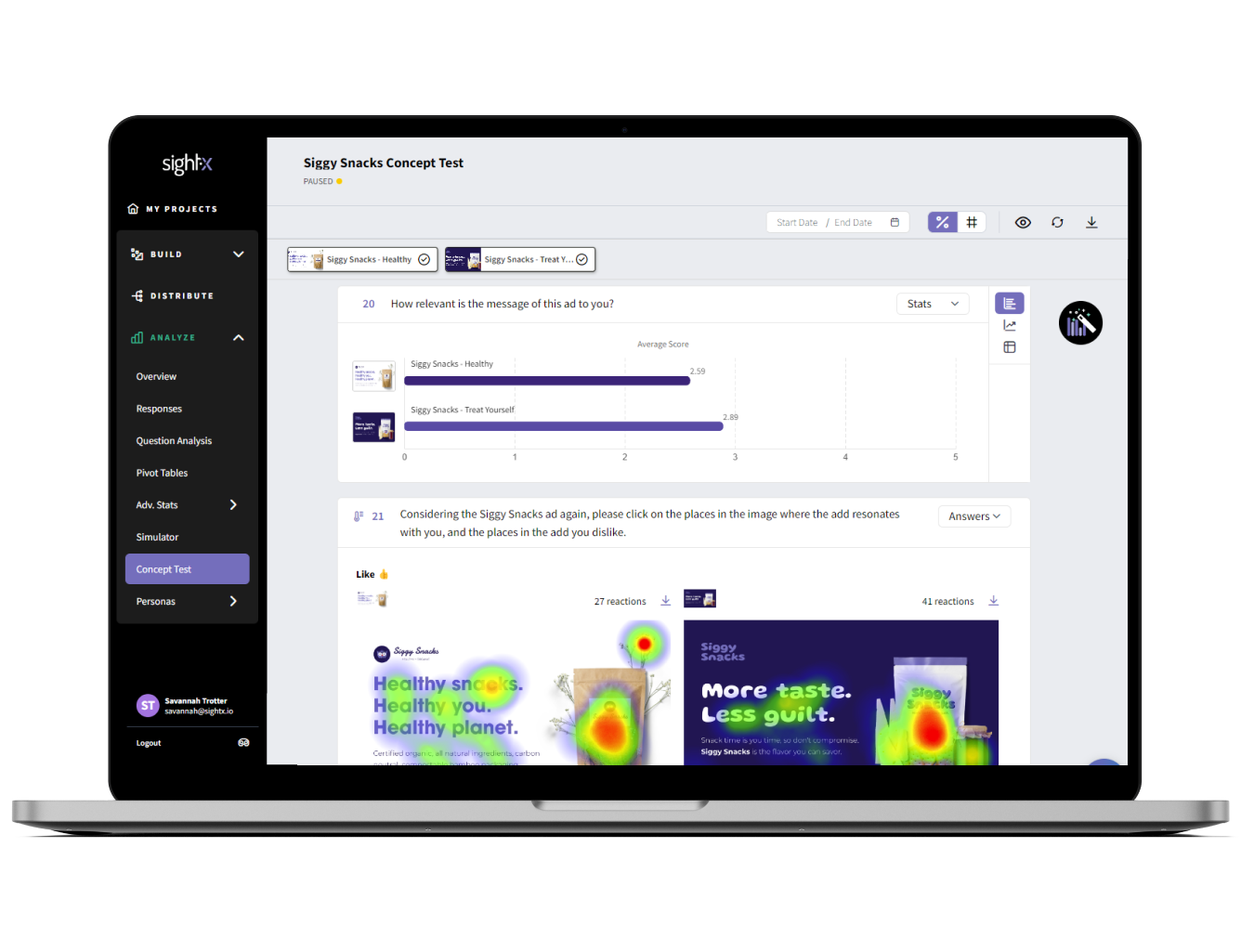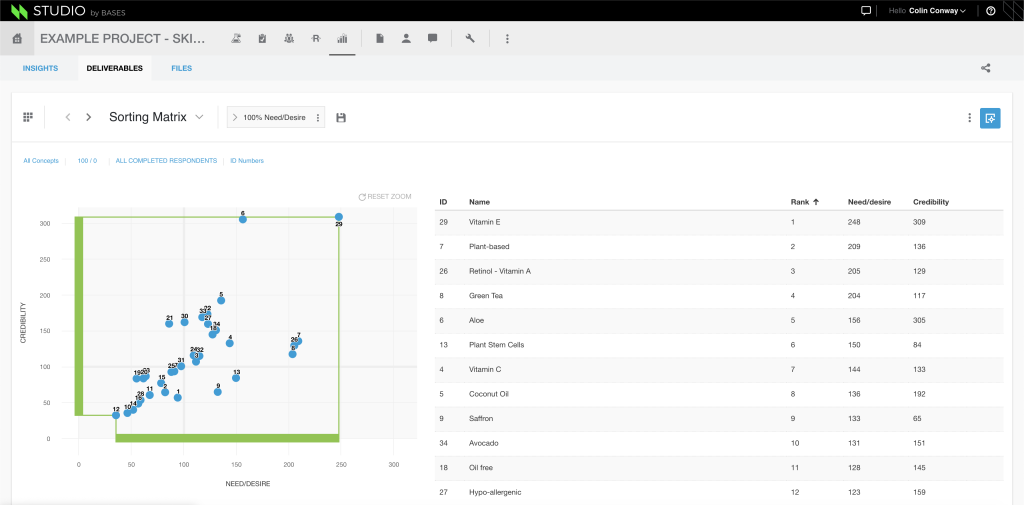It is common knowledge that some of the key ways to stay ahead in business lie in innovation. However, launching a new product or service without understanding its potential reception can be risky.
This is where concept testing comes into play—as a method for testing the viability of new ideas before they hit the market. Today, we'll cover what concept testing is, the essential characteristics of effective concept testing tools, the business problems it can solve, and an in-depth look at some of the best tools on the market.
What is Concept Testing?
Concept testing is a research technique used to evaluate consumer responses to an idea or concept before it's fully developed and launched. This process involves presenting the concept (or concepts) to a target audience through surveys, interviews, or other feedback mechanisms to gather insights into their perceptions, preferences, and likelihood of adoption.
Why is Concept Testing Important?
![]() Validation: Concept testing helps validate the core idea of a product or service. It confirms that there is a demand for the idea and that it resonates with the target audience.
Validation: Concept testing helps validate the core idea of a product or service. It confirms that there is a demand for the idea and that it resonates with the target audience.![]() Optimization: By understanding consumers' reactions, businesses can refine and optimize their concepts. This might involve tweaking features, altering designs, or even changing the target market.
Optimization: By understanding consumers' reactions, businesses can refine and optimize their concepts. This might involve tweaking features, altering designs, or even changing the target market.![]() Risk Reduction: Launching a product without sufficient testing can lead to significant financial losses. Concept testing mitigates this risk by identifying potential issues early and allowing you to course-correct before devoting serious resources.
Risk Reduction: Launching a product without sufficient testing can lead to significant financial losses. Concept testing mitigates this risk by identifying potential issues early and allowing you to course-correct before devoting serious resources.![]() Market Positioning: Concept testing provides valuable insights into how a new product should be positioned in the market relative to competitors.
Market Positioning: Concept testing provides valuable insights into how a new product should be positioned in the market relative to competitors.![]() Resource Allocation: Allocating resources to a product, service, or campaign that will flop is a real risk. Concept testing helps you make more informed decisions, ensuring that you only invest your time and money into worthwhile ideas.
Resource Allocation: Allocating resources to a product, service, or campaign that will flop is a real risk. Concept testing helps you make more informed decisions, ensuring that you only invest your time and money into worthwhile ideas.
Types of Concept Testing
Monadic Testing
This method presents one concept to respondents, ensuring detailed feedback on a single idea.
Sequential Monadic Testing
Respondents are shown multiple concepts in a sequence, allowing for comparative analysis.
Comparative Testing
Multiple concepts are presented side-by-side, and respondents are asked to compare and rank them.
Proto-Monadic Testing
Combines monadic and comparative testing elements, initially presenting one concept, followed by a comparison with others.
Characteristics of Good Concept Testing Tools
If you want your concept tests to yield insightful data, the tools you use should meet some minimum criteria, like:
![]() Ease of Use
Ease of Use
A concept testing tool should be user-friendly, allowing researchers and marketers to create and deploy tests effortlessly. Complex interfaces can slow down the process and lead to errors.
![]() Customization
Customization
The ability to tailor tests to specific needs is crucial. This includes customizing questions, audience targeting, and the type of data collected to ensure the test aligns with the business's unique requirements.
![]() Real-Time Analytics
Real-Time Analytics
Immediate access to data and insights allows for quick decision-making. Real-time analytics help businesses understand consumer feedback as it comes in, enabling rapid adjustments and iterations.
![]() Qualitative and Quantitative Capabilities
Qualitative and Quantitative Capabilities
A mix of both qualitative and quantitative data provides a comprehensive understanding of the concept's reception. Quantitative data offers statistical insights, while qualitative data provides context and deeper understanding.
![]() Integration
Integration
Compatibility with other business tools and platforms enhances efficiency. Integration with CRM systems, marketing tools, and data analysis platforms can streamline the process and provide richer insights.
![]() Scalability
Scalability
The tool should be able to handle projects of various sizes and complexities. Whether you are testing a single concept with a small audience or multiple concepts across different demographics, scalability ensures the tool grows with your needs.
![]() Security
Security
Given the sensitive nature of consumer data, robust security features are non-negotiable. The tool should comply with data protection regulations and offer features like data encryption and secure storage.
5 of the Best Concept Testing Tools
Concept testing tools vary widely in their features and functionalities. Taking into account the range of capabilities, we identified the top five tools that cater to different needs, including a mix of quantitative and qualitative research capabilities.
SightX
SightX is a comprehensive modern research platform. It's powered by AI, emphasizing ease of use and speed of data analysis. SightX offers a range of tools for survey creation, data collection, and analysis, all designed to help businesses make data-driven decisions.
The concept testing tools, specifically, allow for a simple yet flexible approach that helps users get accurate feedback quickly.
Key Features:
![]() Prompt-Based Survey & Test Creation: Thanks to generative AI, SightX users can create surveys, tests, and experiments with a prompt.
Prompt-Based Survey & Test Creation: Thanks to generative AI, SightX users can create surveys, tests, and experiments with a prompt. ![]() Flexibility: SightX provides a large variety of question types, configurations, and even offers heat mapping within their concept testing tool.
Flexibility: SightX provides a large variety of question types, configurations, and even offers heat mapping within their concept testing tool. ![]() Real-Time Data Analysis: Access to real-time data and analytics helps make timely decisions.
Real-Time Data Analysis: Access to real-time data and analytics helps make timely decisions.![]() AI-Driven Insights: With SightX's AI consultant, Ada, you can get immediate answers to your questions, key insights pulled from your data, and full summaries for reporting. All with a simple prompt.
AI-Driven Insights: With SightX's AI consultant, Ada, you can get immediate answers to your questions, key insights pulled from your data, and full summaries for reporting. All with a simple prompt.
Why Use SightX: SightX is perfect for businesses that need comprehensive research tools, faster turnarounds, and accurate insights without sacrificing their budget or time. Its real-time analytics and AI capabilities set it apart as a forward-thinking tool for concept testing.

UserTesting
UserTesting provides qualitative feedback through video recordings of real users interacting with your concept. This tool is excellent for understanding user experience and gathering detailed insights.
Key Features:
![]() Video Recordings: Captures video recordings of users interacting with your product, providing rich qualitative data.
Video Recordings: Captures video recordings of users interacting with your product, providing rich qualitative data.![]() Targeted Demographics: Allows businesses to select specific demographics to ensure feedback is relevant.
Targeted Demographics: Allows businesses to select specific demographics to ensure feedback is relevant.![]() Detailed Analysis: Provides tools for detailed analysis and highlight reels to easily share critical insights.
Detailed Analysis: Provides tools for detailed analysis and highlight reels to easily share critical insights.![]() Quick Turnaround: A fast feedback loop enables rapid iterations and improvements.
Quick Turnaround: A fast feedback loop enables rapid iterations and improvements.
Why Use UserTesting: UserTesting delivers in-depth qualitative feedback, making it ideal for user experience testing and identifying pain points in your concept.
Lookback
Lookback is a qualitative research tool focused on user experience. It allows for live user testing sessions, interviews, and feedback collection, providing a rich understanding of user interactions.
Key Features:
![]() Live User Testing: Conduct live sessions with users to observe their real-time interactions.
Live User Testing: Conduct live sessions with users to observe their real-time interactions.![]() Session Recordings: Record sessions for later analysis, complete with annotations and comments.
Session Recordings: Record sessions for later analysis, complete with annotations and comments.![]() Real-Time Collaboration: Teams can collaborate in real-time, making it easy to discuss findings and make decisions.
Real-Time Collaboration: Teams can collaborate in real-time, making it easy to discuss findings and make decisions.![]() Integration: Integrates with other UX tools to provide a seamless research experience.
Integration: Integrates with other UX tools to provide a seamless research experience.
Why Use Lookback: Lookback is ideal for teams that need to conduct detailed UX research and want the ability to interact with users in real time.

Discuss.io
Discuss.io is a video conferencing platform tailored for qualitative research. It enables moderated interviews and focus groups, offering deep insights into consumer opinions and behaviors.
Key Features:
![]() Video Interviews: Conduct and record video interviews and focus groups with consumers.
Video Interviews: Conduct and record video interviews and focus groups with consumers.![]() Automated Transcription: Provides automated transcription and translation services for global research.
Automated Transcription: Provides automated transcription and translation services for global research.![]() Analytical Tools: Includes tools for analyzing interviews and identifying trends and patterns.
Analytical Tools: Includes tools for analyzing interviews and identifying trends and patterns.![]() Participant Recruitment: Offers participant recruitment services to ensure you get feedback from the right audience.
Participant Recruitment: Offers participant recruitment services to ensure you get feedback from the right audience.
Why Use Discuss.io: Discuss.io is perfect for conducting in-depth qualitative research, particularly for global studies requiring multilingual capabilities.
Nielsen BASES
A comprehensive tool for concept testing, powerful predictive analytics, and market simulation.
Key Features:
![]() Predictive Analytics: Nielsen BASES uses advanced statistical models to forecast new products' potential market performance and success.
Predictive Analytics: Nielsen BASES uses advanced statistical models to forecast new products' potential market performance and success.![]() Market Simulation: This feature creates virtual market environments to test strategies and predict real-world outcomes.
Market Simulation: This feature creates virtual market environments to test strategies and predict real-world outcomes.![]() Custom Research Solutions: Nielsen BASES provides tailored research methodologies to meet each business's specific needs and objectives.
Custom Research Solutions: Nielsen BASES provides tailored research methodologies to meet each business's specific needs and objectives.![]() Global Reach: With operations in over 100 countries, Nielsen BASES offers extensive insights into diverse markets and consumer behaviors worldwide.
Global Reach: With operations in over 100 countries, Nielsen BASES offers extensive insights into diverse markets and consumer behaviors worldwide.
Why Use Nielsen BASES: Use Nielsen BASES to leverage its advanced predictive analytics, market simulations, and global insights for accurately forecasting product success and optimizing marketing strategies.

Concept Testing with SightX
Choosing the right concept testing tool is essential for ensuring the success of your new ideas. Tools like SightX offer a range of features that cater to different needs, from rapid quantitative analysis to in-depth qualitative research.
Investing in effective concept testing not only saves time and resources but also enhances your ability to deliver products and services that truly resonate with your target audience.
If you're ready to take your products to the next level, start a free trial today:
More stories
Automating Curiosity
Meet the next generation of consumer insights





